The Chang'e-4 mission - the results of the fifth lunar day: problems with the Yuuta-2 rover and a new scientific discovery
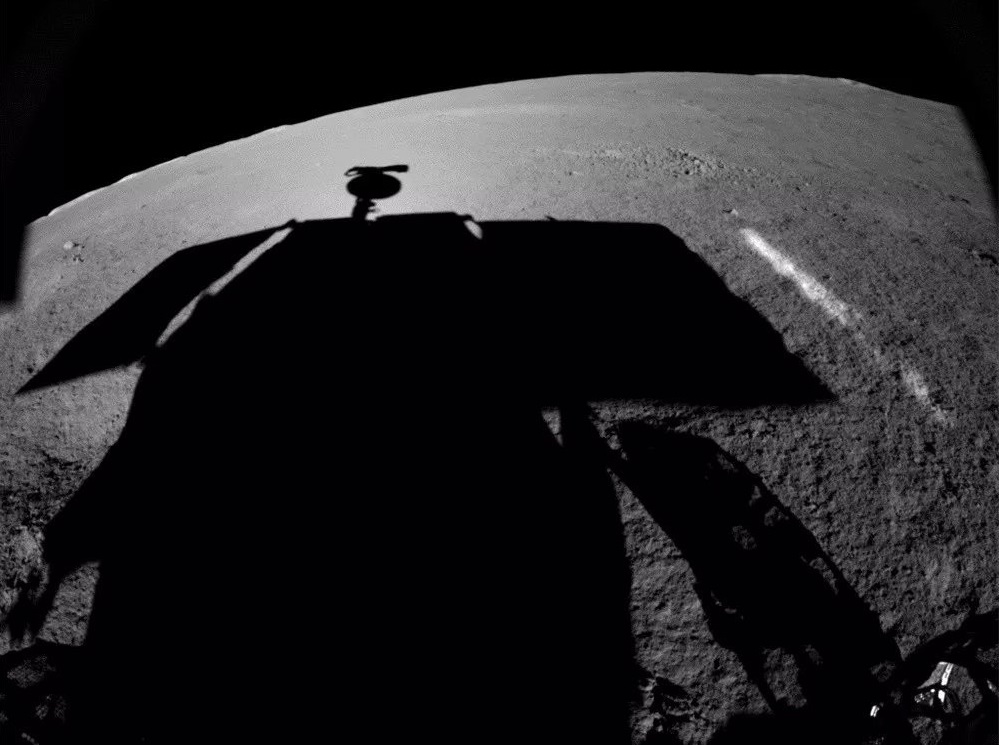
The missions of the Chang'e-4 mission (descent module and rover) successfully carried out scientific research during their fifth lunar day on the far side of the moon, sending more than 6.6 GB of scientific data to Earth, and analyzing some of them from the spectrometer rover "Yuytu-2" on the composition of the mantle of the moon, was a new scientific discovery.
But the operators of the rover "Yuuta-2" had to make some efforts to compensate for the negative impact of the problem that arose in the autonomous driving system.
Previously published materials about the mission "Chang'e-4":
1. The spacecraft "Chang'e-4" made a successful landing on the far side of the moon and sent the first photo
')
2. On-board video of the processes of preparation and landing, as well as a panorama of the far side of the Moon from Chang'e-4
3. Video of the descent of the rover "Yuytu-2", its first meters on the surface of the moon. Two week sleep on the moon is over
4. Pride and Passion, the story of turning a dream into a space project
5. NASA lunar orbital probe made the first pictures of the China Chang'e-4 station - two pixels of light
6. Module "Chang'e-4" and rover "Yuytu-2" are ready for the second night on the far side of the moon
7. NASA lunar orbital probe made new images of the China Chang'e-4 station - closer and clearer
8. Interesting facts about the history of the Chinese lunar program and the Chang'e-4 space mission
9. The Chang'e-4 mission is the third lunar day. Rover "Yuytu-2" in search of ... stones
10. The mission “Chang'e-4” - scientific equipment on the landing module and the satellite transponder
11. The Chang'e-4 mission is the fourth lunar day for the landing module and the Yuuta-2 rover. Pro cameras and controllers on devices
12. Mission “Chang'e-4” - the fifth lunar day for the landing module and rover “Yuytu-2”
13. Communication with the reverse side of the Moon - satellite Tseutsyao (Shorter bridge)
1. The spacecraft "Chang'e-4" made a successful landing on the far side of the moon and sent the first photo
')
2. On-board video of the processes of preparation and landing, as well as a panorama of the far side of the Moon from Chang'e-4
3. Video of the descent of the rover "Yuytu-2", its first meters on the surface of the moon. Two week sleep on the moon is over
4. Pride and Passion, the story of turning a dream into a space project
5. NASA lunar orbital probe made the first pictures of the China Chang'e-4 station - two pixels of light
6. Module "Chang'e-4" and rover "Yuytu-2" are ready for the second night on the far side of the moon
7. NASA lunar orbital probe made new images of the China Chang'e-4 station - closer and clearer
8. Interesting facts about the history of the Chinese lunar program and the Chang'e-4 space mission
9. The Chang'e-4 mission is the third lunar day. Rover "Yuytu-2" in search of ... stones
10. The mission “Chang'e-4” - scientific equipment on the landing module and the satellite transponder
11. The Chang'e-4 mission is the fourth lunar day for the landing module and the Yuuta-2 rover. Pro cameras and controllers on devices
12. Mission “Chang'e-4” - the fifth lunar day for the landing module and rover “Yuytu-2”
13. Communication with the reverse side of the Moon - satellite Tseutsyao (Shorter bridge)
Data on the project and modules of the lunar mission "Chang'e-4":
May 21, 2018: The Tseyuqiao satellite relay (Forty Bridge) was launched from the Xichang Cosmodrome Chinese Cosmodrome, it is necessary for organizing the connection between the Earth and the far side of the Moon.
June 14, 2018: The Tseuqiao satellite relay went into halo orbit around the Earth-Luna Lagrange point L2, approximately 65,000 km from the Moon, becoming the world's first communications satellite operating in this orbit.
December 8, 2018: The Changzheng-3B launch vehicle with the Chang'e-4 station was successfully launched from the Xichang Chinese cosmodrome.
January 3, 2019: the Chang'e-4 descent vehicle lands in the Pocket crater on the far side of the Moon. The Chang'e-4 landing gear includes the second Chinese moon rover, Yuytu-2, a modernized version of the Yuytu rover. The missions of the Chang'e-4 mission are now continuing to work in a regular mode and send data to Earth for the fifth month.
Video boarding and landing of the rover
Video of the landing procedure on the reverse side of the moon:
After the completion of all stages of the successful landing procedure and the installation of independent communication channels with the Chang'e-4 vehicles (the landing module and the rover), the era of exploration of the far side of the moon began, which has already been going on for the fifth month.
Video of the descent of the rover "Yuytu-2":
Video of the first trip of the rover "Yuytu-2":
After the completion of all stages of the successful landing procedure and the installation of independent communication channels with the Chang'e-4 vehicles (the landing module and the rover), the era of exploration of the far side of the moon began, which has already been going on for the fifth month.
Video of the descent of the rover "Yuytu-2":
Video of the first trip of the rover "Yuytu-2":
Chang'e-4 descent module:
- 4.4 meters between the opposite landing supports, weight 1200 kg .;
- work duration: one earth year.
The following devices are installed on the “Chang'e-4” descent module:
- LFS - Low Frequency Spectrometer (low-frequency spectrometer);
- LND - Lunar Lander Neutrons and Dosimetry (neutron dosimeter);
- TCAM - Terrain Camera (landscape camera);
- LCAM - Landing Camera (landing camera).

Rover "Yuytu-2":
- height 1 meter, width 1 meter (without solar batteries), 1.5 meters in length, two folding solar panels, six wheels;
- the total mass of the rover is about 140 kg (310 pounds);
- capacity - about 20 kg (44 lbs);
- can move on slopes and has automatic sensors that prevent collisions with other objects;
- electricity rover is provided with two solar panels, allowing the rover to work during the lunar day;
- the maximum speed of 200 meters per hour (this speed on the Moon will not be reached anyway, since the elements on the surface will not allow acceleration and disable the rover earlier);
- The maximum study area is 3 square meters. km;
- the estimated working time is 3 months (2160 hours), the rover has already exceeded its service life by two months;
- the maximum estimated distance is 10 km, 190.66 meters on the lunar surface in five months are now covered (1 place among the rovers on the far side of the moon, the sixth place among all lunar rovers), the table of the distance of the rovers is shown here ;
- control mode: automatic (detour of small obstacles), manual (main) - the operator controls from the Earth.
The following devices were installed on the Yuytu-2 rover:
- LPR - Lunar Penetrating Radar (moon georadar);
- ASAN - Advanced Small Analyzer for Neutrals (small analyzer of neutral particles);
- VNIS - Visible and Near-Infrared Imaging Spectrometer (infrared spectrometer);
- PCAM - Panoramic Camera (dual panoramic camera).
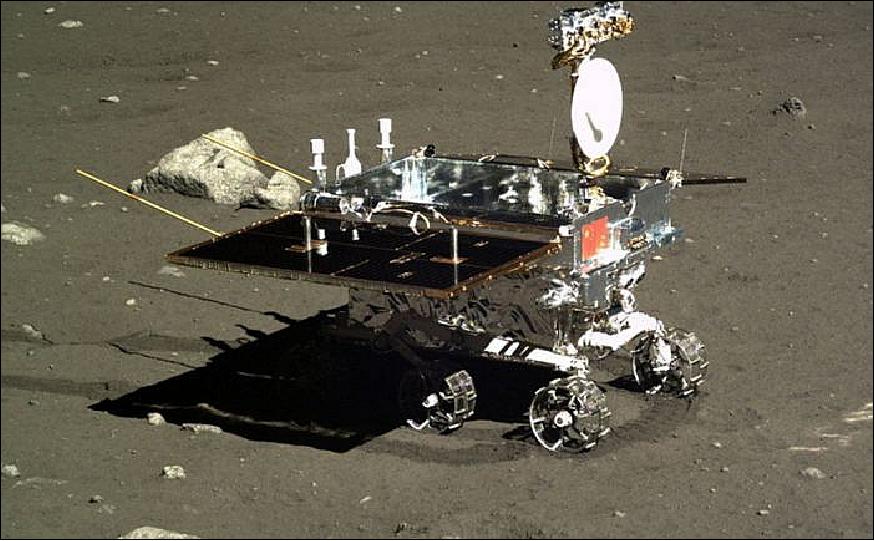
The fifth lunar working day ended, here are some new photos from the back of the moon sent vehicles to Earth.
Beautiful shadow from the newly awakened rover "Yuytu-2":


Interesting surface of the far side of the moon:


Traces of the “Yuytu-2” rover and small stones that he rides around:
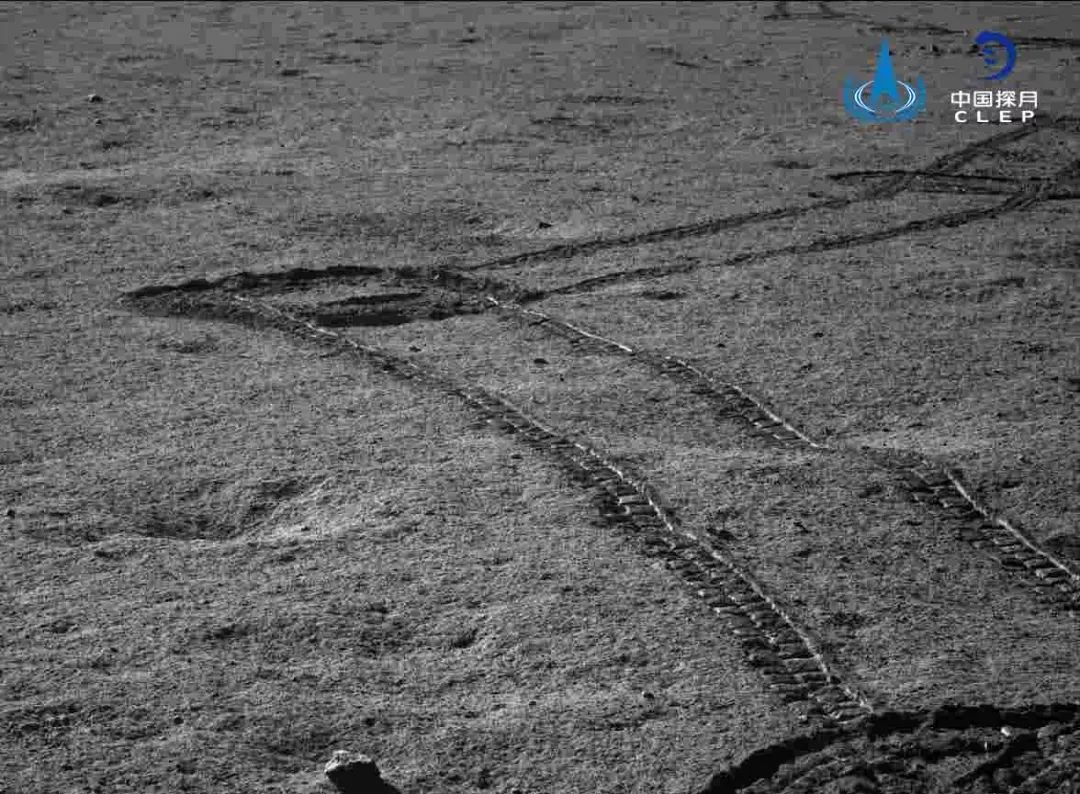


But what stones remain on the side of the route of the rover "Yuytu-2":
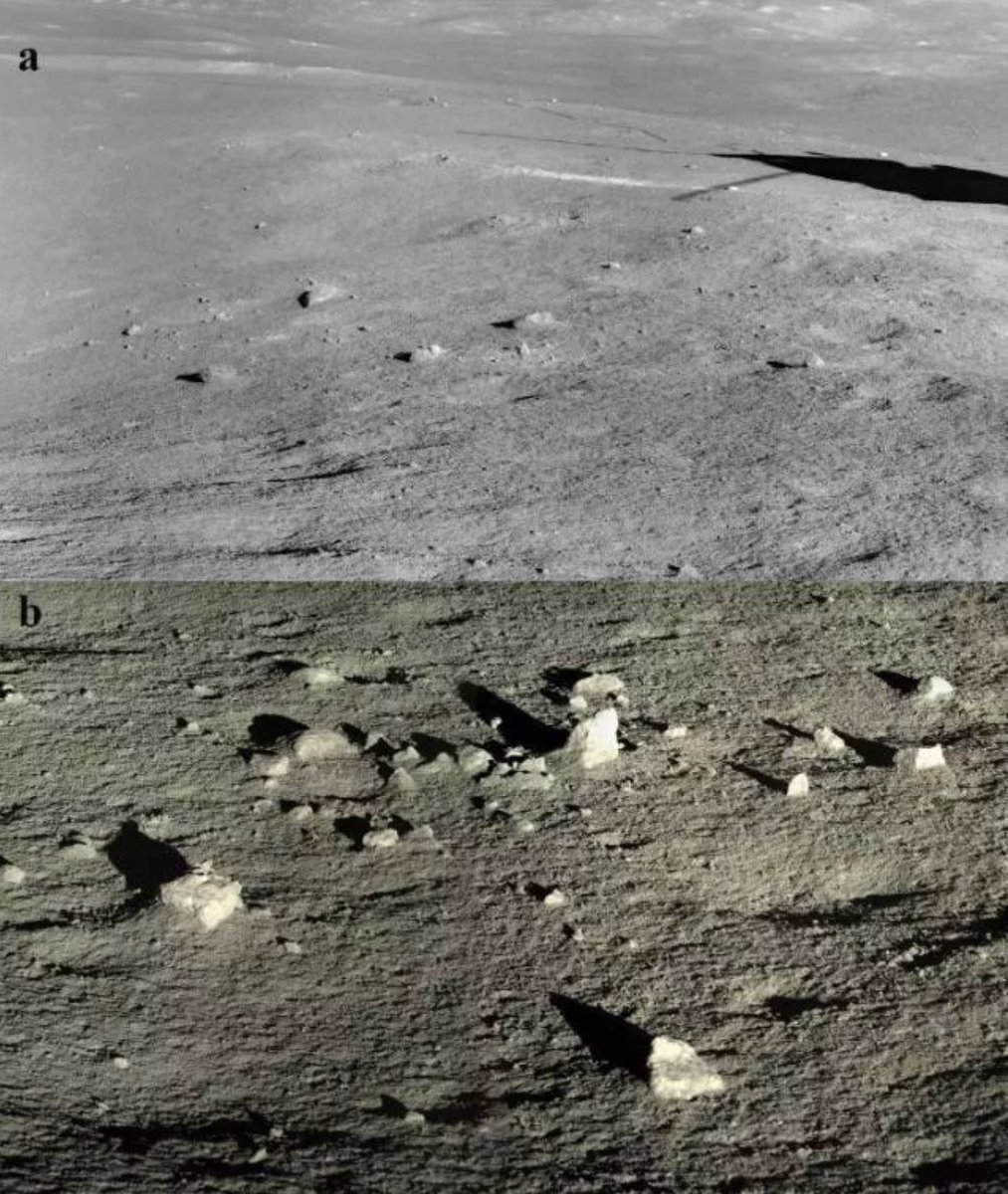
Binding of the panorama from the descent module to the real relief of the far side of the Moon in the landing zone:
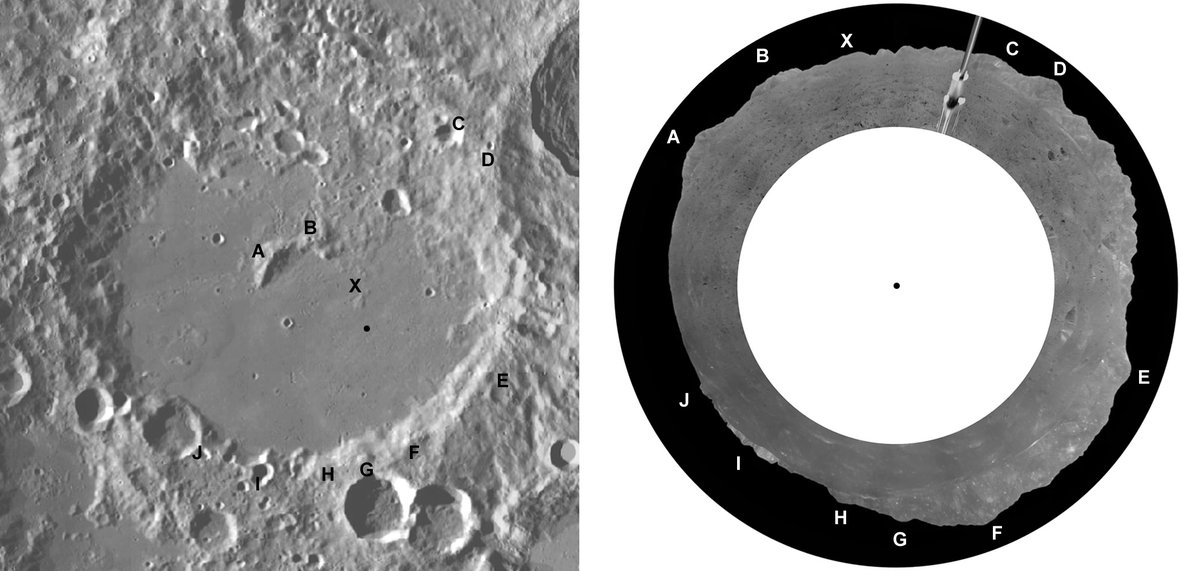
Very distant mountains, increasing from the landing module's camera:

And the longest photo, the Chang'e-4 lander, is now more than 100 meters from the Yuuta-2 rover (and the probability that the rover will return to the lander is very small):
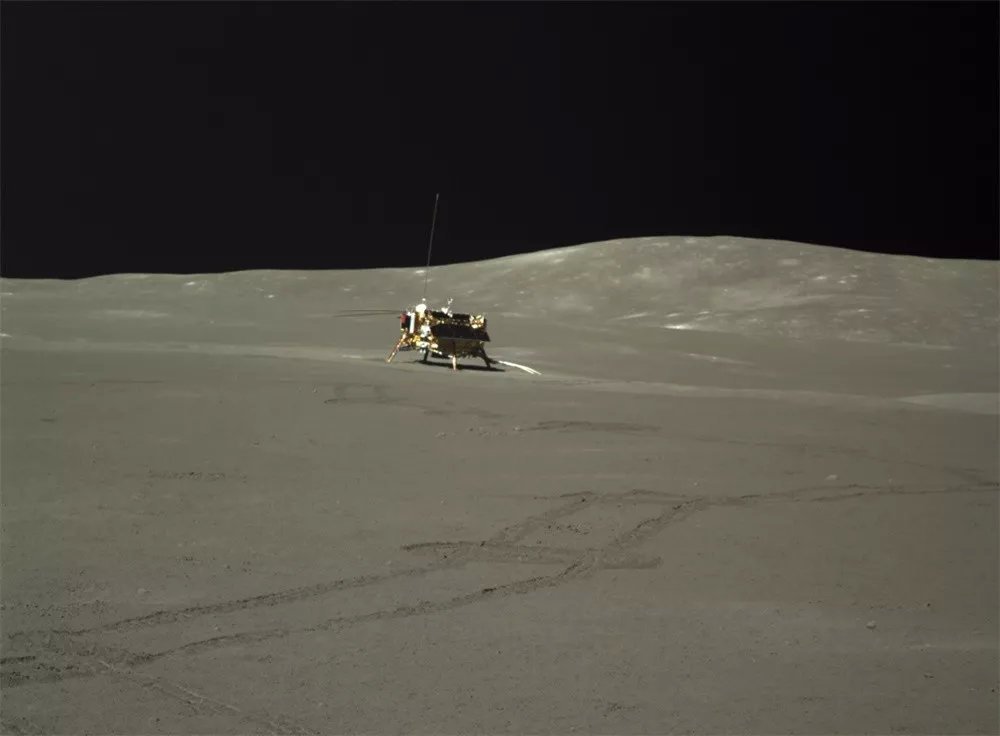

This is how far (his total distance in five lunar days is 190.66 meters) that the Yuyuta-2 rover left the landing site and the Chang'e-4 descent vehicle:
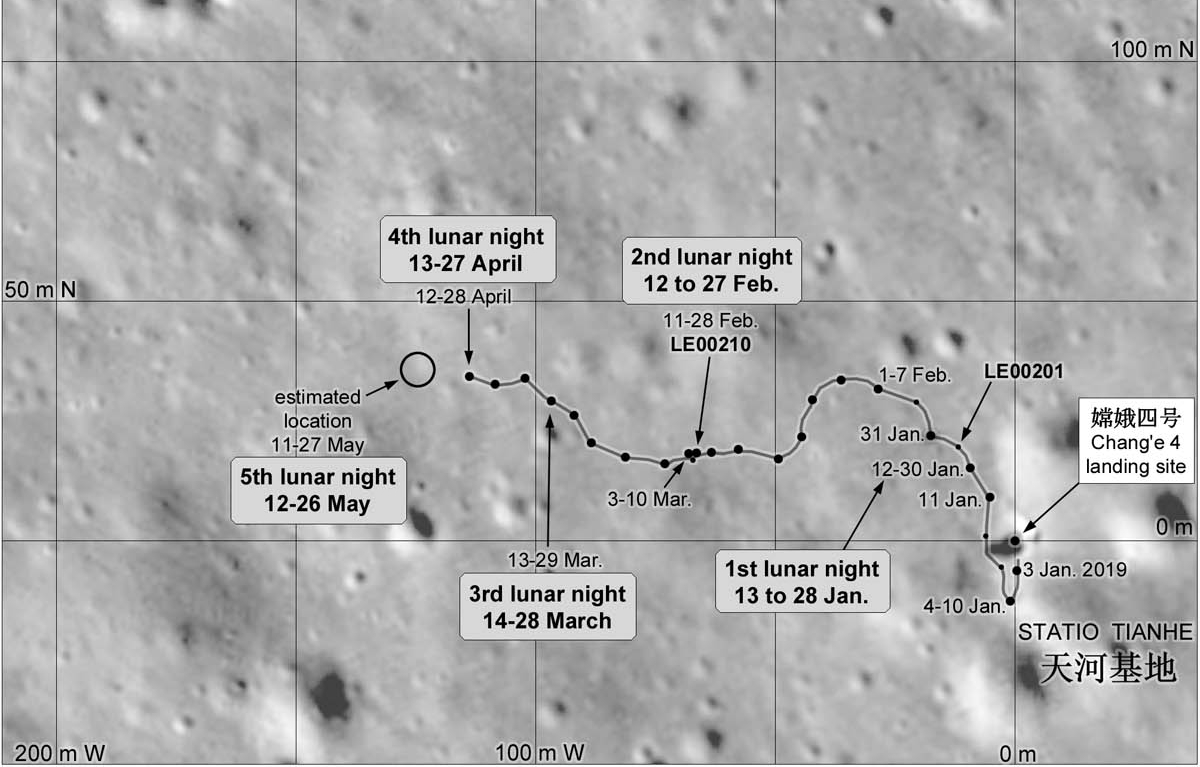
By the way, on the basis of the discovery, which will be discussed later in the publication, the operators of the Yuuta-2 rover were given the command to lead the rover away from the landing site at least two kilometers in order to be able to conduct scientific research and compare the results with the data obtained near landing sites.
Thus, the “Yuuta-2” rover is waiting for a large and complex journey to the center of the crater Karman.
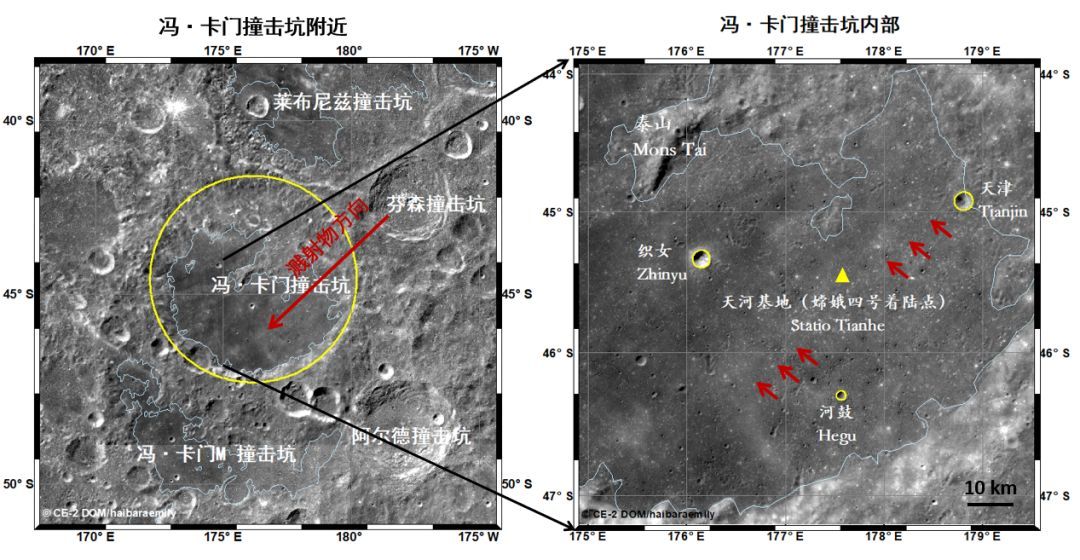
What problems have arisen with the “Yuytu-2” rover on the fifth lunar day of its work?
In fact, the estimated operating time of the “Yuuta-2” rover is three earthly months, and almost two times have already passed, so breakdowns and problems with the elements of the “Yuuta-2” rover should begin.
Why he could so exceed his work time? Because the operators on Earth did their best to protect his movements on the far side of the moon, minimizing the possibility of damage.
For the first two lunar days, the Yuuta-2 rover drove 120 meters (this is a reconnaissance of the landing site and a study of the surface of the far side of the moon), on the third lunar day, the rover drove 43 meters (the operators started the research and development phase of the project, at which the rover needs a long time to stay in one place, so that on this day places for research were identified and studied), on the fourth lunar day the rover traveled 16 meters, on the fifth lunar day already 12 meters, measuring on its odometer a distance of 190.66 meters, which was covered they need fraternal side of the moon.
Why, on the fifth lunar day, did the Yuytu-2 rover drive very little?
It turns out that he had a breakdown in the automatic obstacle avoidance system.
Using this system, the Yuytu-2 rover can automatically carry out a detour of small obstacles that will fix its onboard cameras and sensors.
If there is a big stone or a crater in front of him, he can independently stop and plan a new route bypassing this place, in this case, the operator at the MCC can register this situation and rebuild the planned route to a new one after the maneuver bypass rover automatically and stop.
So, on the fifth lunar day, the sensors of the automatic obstacle avoidance system, which activate the alarms in case of obstacles in front of the rover, began to work abnormally near the Yuyu-2 rover. Because of this, the Yuuta-2 rover froze several times, and at that moment control was not transferred to the operators on Earth.
The reason for the failure of the rover obstacle avoidance system was established fairly quickly - the sensors of the system were illuminated due to the reflection of sunlight from the rover body elements.

Operators at the PMU on Earth were able to compensate for this situation by adjusting the obstacle avoidance system software and rebooting this system on the rover. Only after all these remote manipulations from the Earth were completed, did the “Yuuta-2” rover be able to continue its research of the far side of the Moon in the normal mode.
What new discovery did the Yuytu-2 rover use with its scientific instrument VNIS - Visible and Near-Infrared Imaging Spectrometer (infrared spectrometer)?
What is this scientific device VNIS, which is installed on the rover "Yuytu-2".
The VNIS (The Visible and Near-Infrared Imaging Spectrometer) lunar infrared spectrometer was developed at the Shanghai Technical Physics Institute of the Chinese Academy of Sciences.
The spectrometer uses non-collinear acousto-optic tunable filters, it consists of a VIS / NIR video spectrometer (0.45–0.95 μm) and a short-wave IR spectrometer (0.9–2.4 μm), it also has a calibration block with protection from dust and dirt.
The spectrometer is installed on the front aboard the Yuuta-2 rover; it has the following limitations on positioning and working with lunar material (the operator on Earth must literally catch interesting surface areas in a small window in front of the rover):
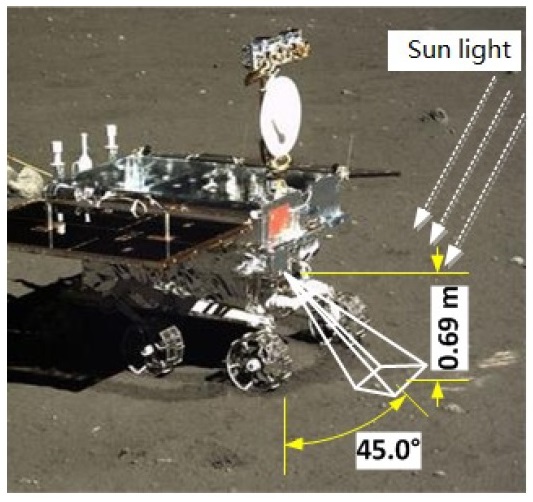

Minerals, such as pyroxene, plagioclase, olivine and ilmenite, which constitute the majority of lunar surface rocks, have distinctive spectral characteristics:

The structural scheme of the spectrometer:
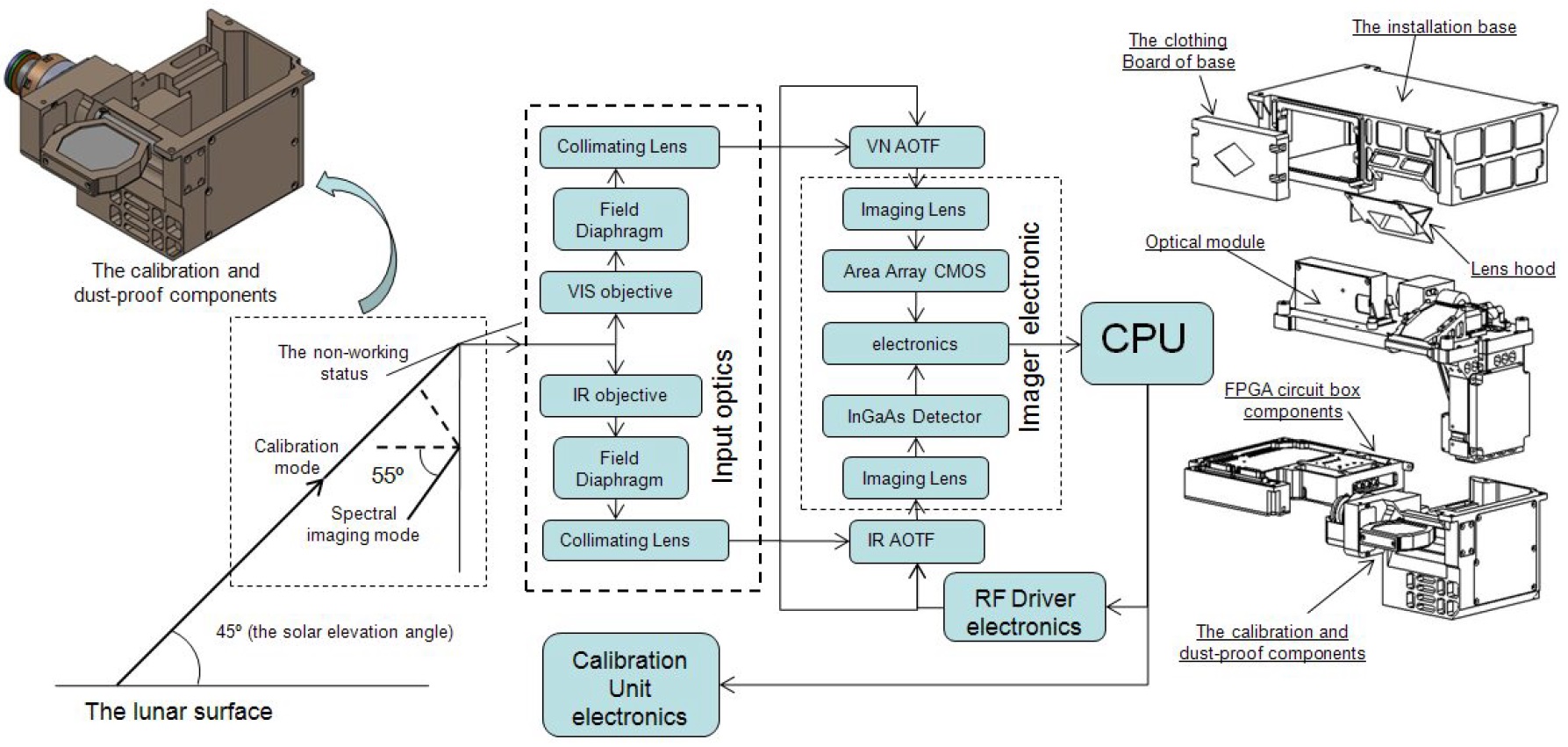
Main technical characteristics of the spectrometer:

The appearance of the spectrometer:
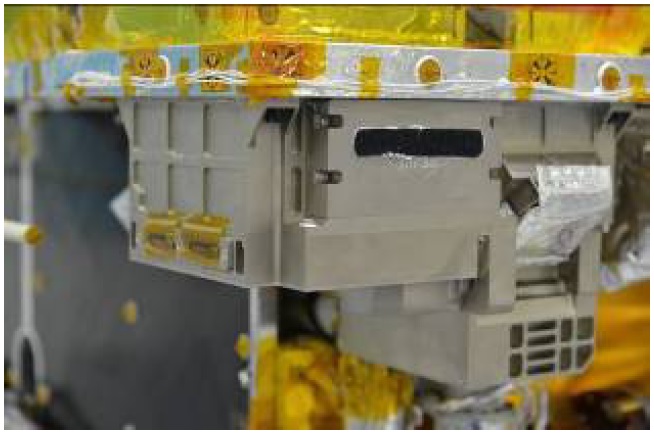
Geometrical dimensions of the detection window:

The data obtained by the spectrometer:
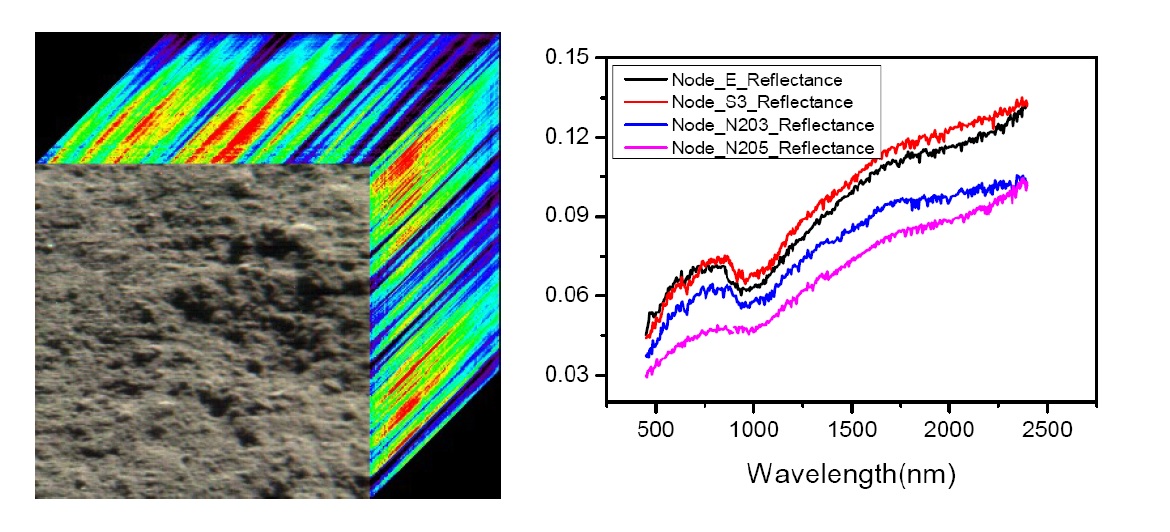
The most difficult task for the Yuytu-2 rover is to get scientific data using an on-board stationary spectrometer VNIS (Visible and Near-Infrared Imaging Spectrometer), which has a width of sensor field of view only a few centimeters, so the rover must be positioned very accurately Yuytu-2, so that the spectrometer's “eye” can be drawn to the desired portion of the lunar surface to obtain correct data from the optimal distance.

After his short walk on the moon, the Yuuta-2 rover reached an interesting stone “clearing” in the center of which a large stone with a diameter of 20 centimeters was found. Scientists were immediately interested in this find, its origin (meteorite, lunar formation) and the process of formation.
General view of the surface panorama during the search for stones:
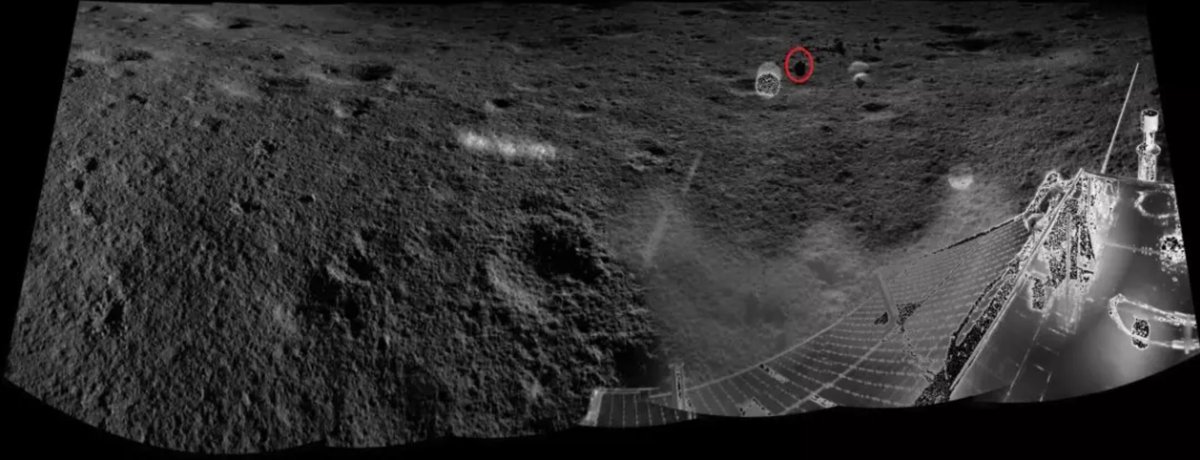
Stony surface, to a large stone (its diameter is 20 centimeters) a distance of 120 centimeters:
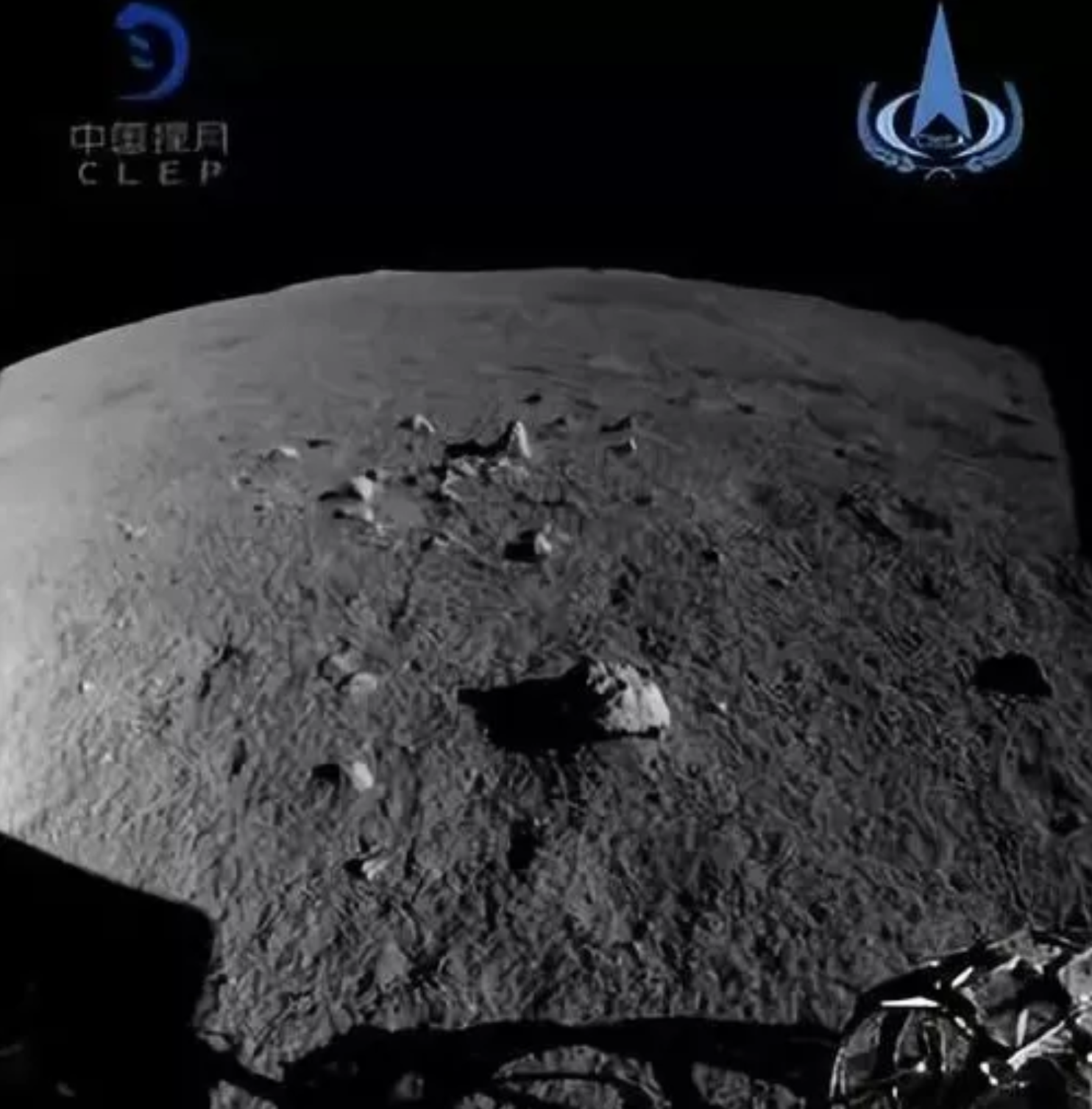
Large image of a large stone:
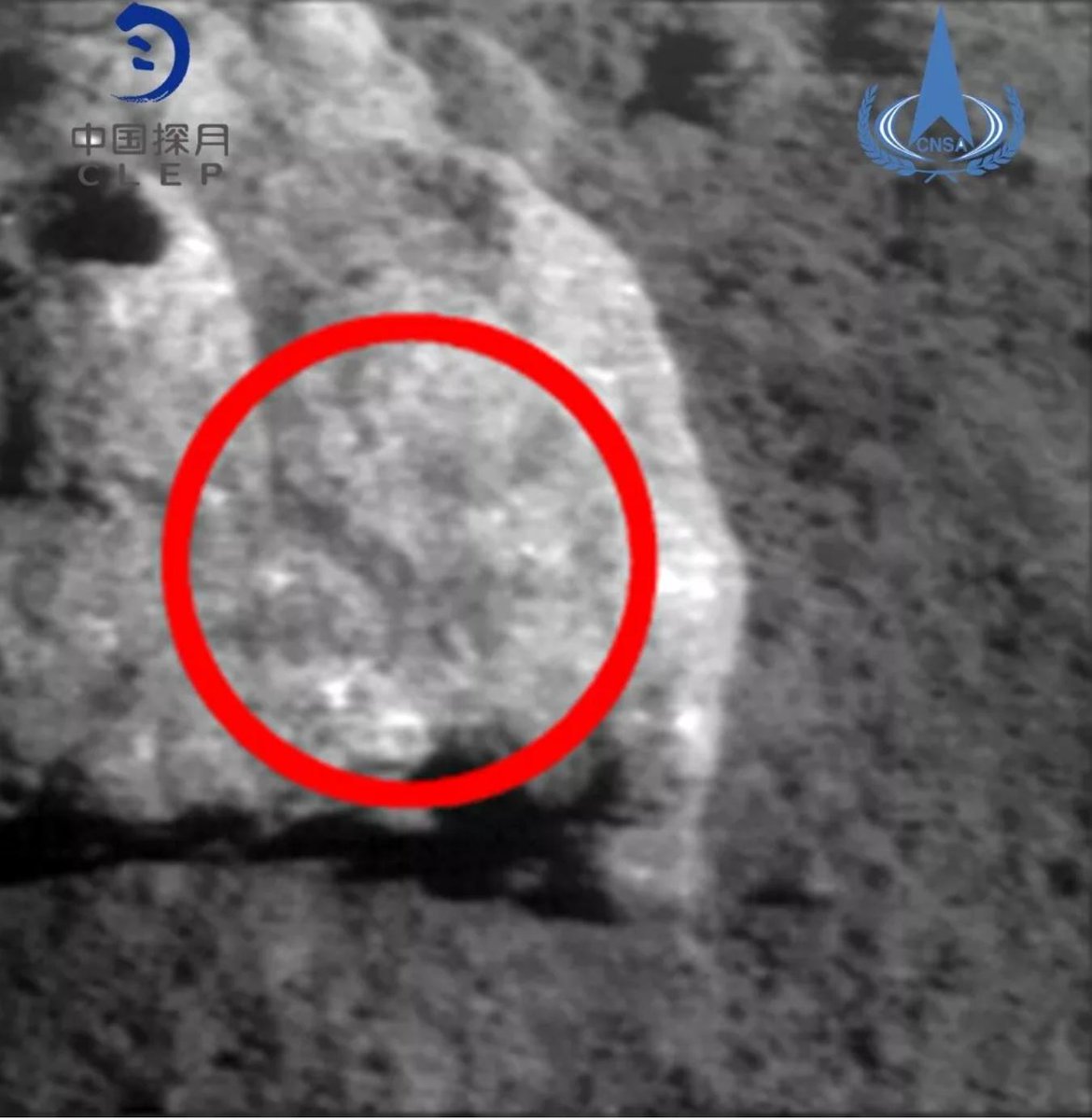

Work with a spectrometer:


Further, the data from the spectrometer rover "Yuytu-2" are transmitted to the aerospace control center of the Chinese Academy of Space Technology, where they are analyzed, stored and some of them finally become open to the scientific community and the world .
The planetary feature of the deep structure of the Moon is its division into a powerful rigid, cold outer sphere and a heated, partially melted and plastic inner region.
The average thickness of the moon's crust is 68 km, varying from 0 km under the lunar sea of Crises to 107 km in the northern part of Korolev crater on the back side.
Under the crust there is a mantle and a small core of iron sulphide (radius of approximately 340 km and a mass of 2% of the mass of the moon).
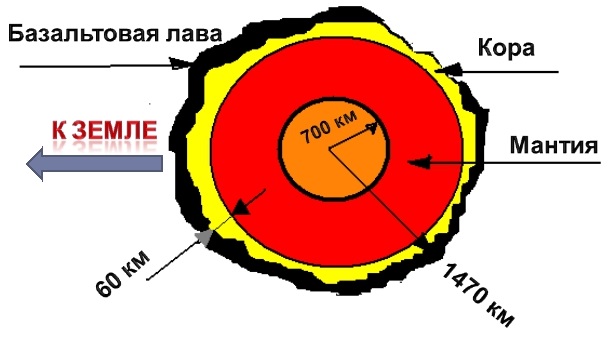
However, on the far side of the moon, the crust is thinner and easier to explore the mantle of the moon.
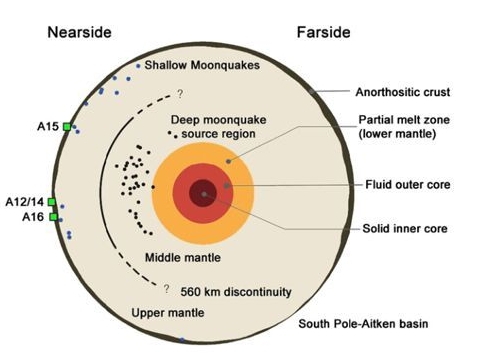
Scientists from the Chinese Academy of Sciences presented the primary results of the analysis from the surface of the far side of the moon using the VNIS spectrometer - the first data on the composition of the lunar mantle were obtained, it turns out that it contains iron-rich minerals.
The elements found on the lunar surface in two of the studied areas by the “Yuuta-2” rover using a VNIS spectrometer were found to contain the presence of pyroxenes and olivines, minerals with a high iron content.

These rocks were originally part of the upper mantle and were on the surface of the moon due to the fall of meteorites and asteroids.
In this case, the moon's crust consists of lighter minerals of the class of plagioclases.
Of course, this discovery requires additional confirmation and detailed study of the samples. But already many scientists declare that, in general, the new data "are obtained within the framework of the correct and accurate application of spectroscopic methods, and the mineral composition is determined quite reliably."
The landing site for missions of the Chang'e-4 mission is located in the Karman crater, in the South Pole-Aitken basin, which is 8 km deep.
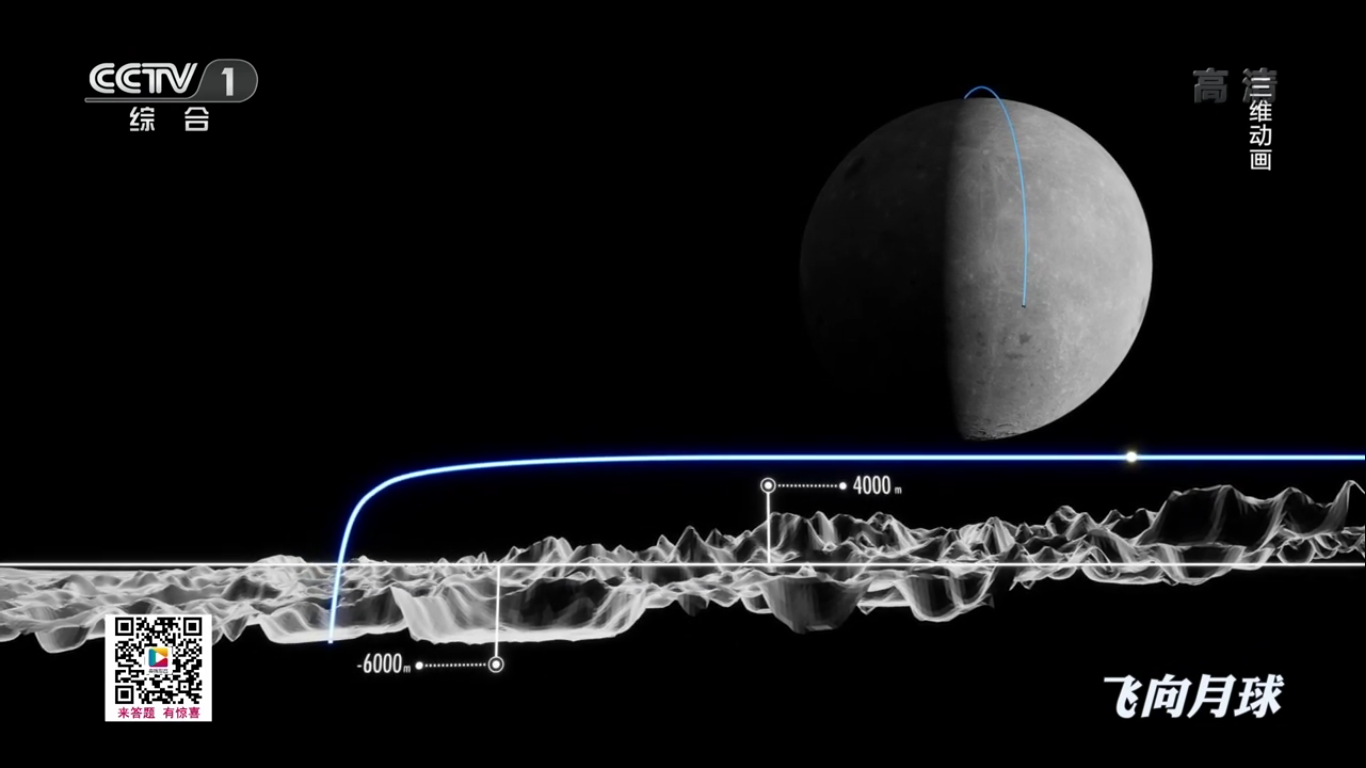
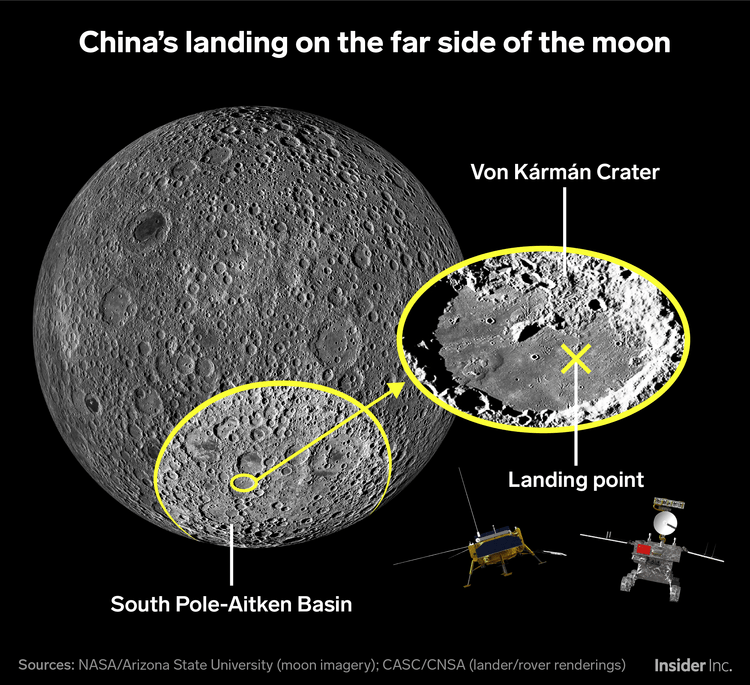

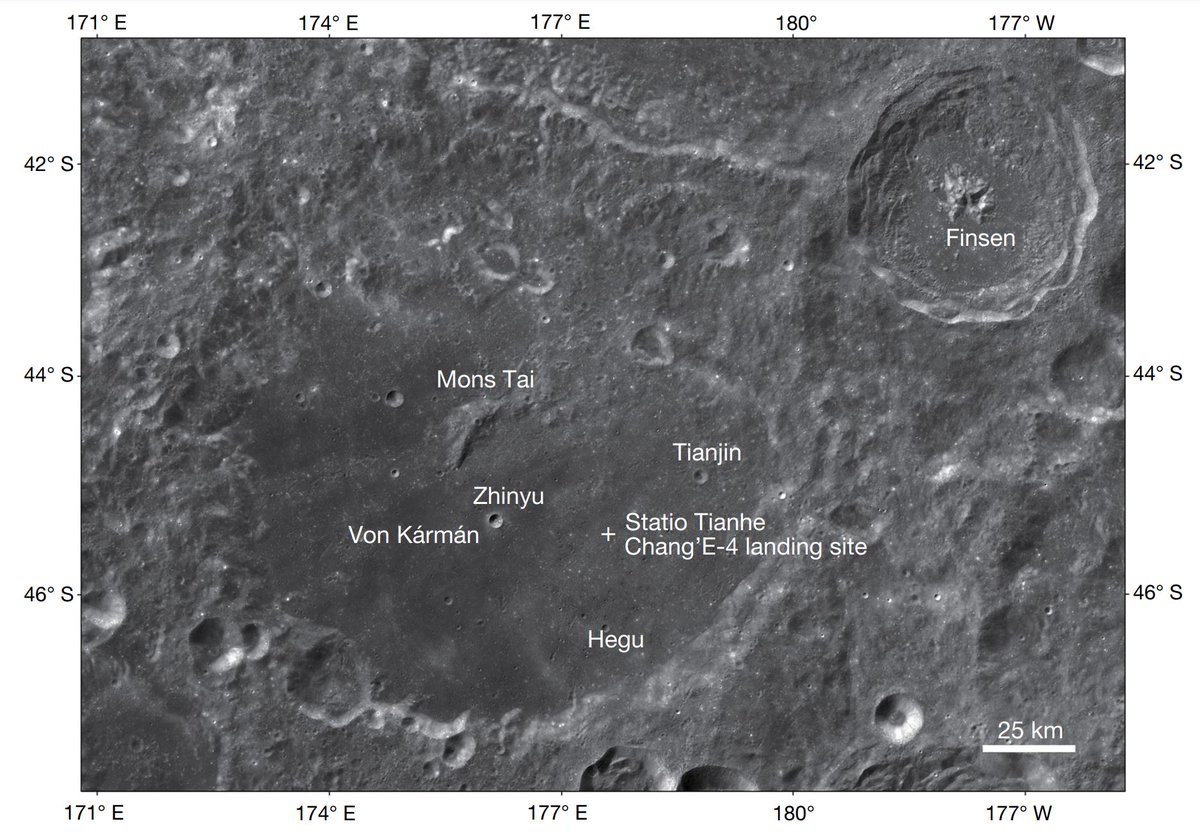
Topographic photograph of the landing zone in the Pocket crater of the far side of the moon of the Chang'e-4 descent module (made by LRO probe, NASA):

The South Pole-Aitken basin is 4.2–4.3 billion years old. It was formed due to the impact of great power.
Simulation of the impact on a close to vertical trajectory shows that a considerable amount of the Moon’s substance had to be ejected to the surface from depths up to 200 kilometers - from the mantle (the lunar crust was pierced to the bottom layer).
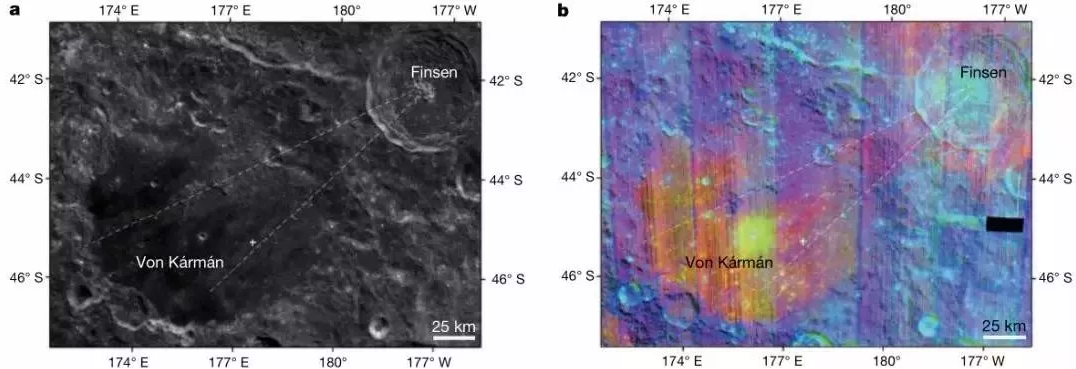
Thus, the Yuytu-2 rover using a VNIS spectrometer in the crater Karman discovered stones and rocks on the surface of the back side of the moon, which came from great depths, presumably from the mantle.
How the research was conducted.
After analyzing photographs and obtaining primary spectrograms of different places on the lunar surface on the rover route, operators and scientists at the PCO on Earth chose two places (between them about 50 meters) to conduct a complete research cycle there (to receive data in one such cycle several earthly days).
With the help of the VNIS spectrometer, Rover "Yuytu-2" carried out extensive studies of the lunar surface at two points of the route (CE4_0015 and CE4_0016):

The data of these measurements, after analysis and processing on Earth:


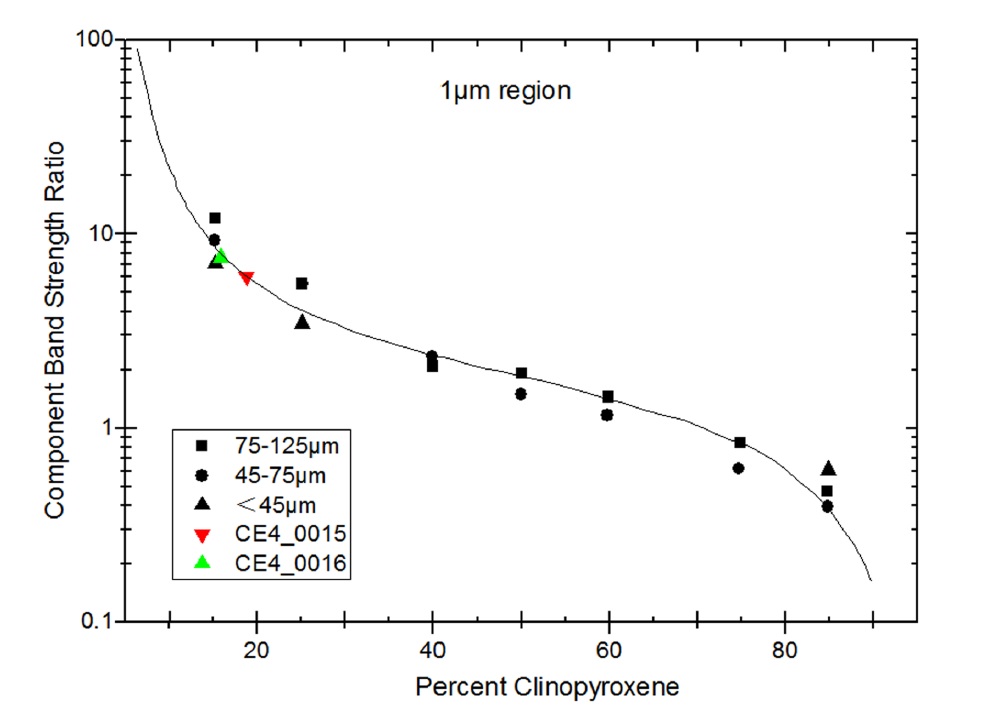
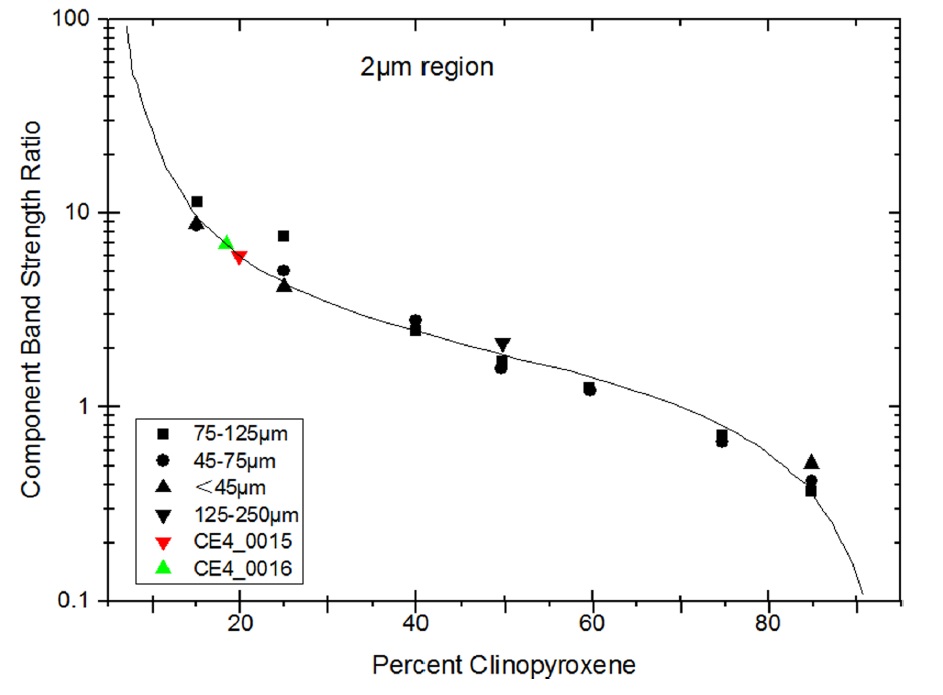

Here for comparison test calibration samples on the chart:
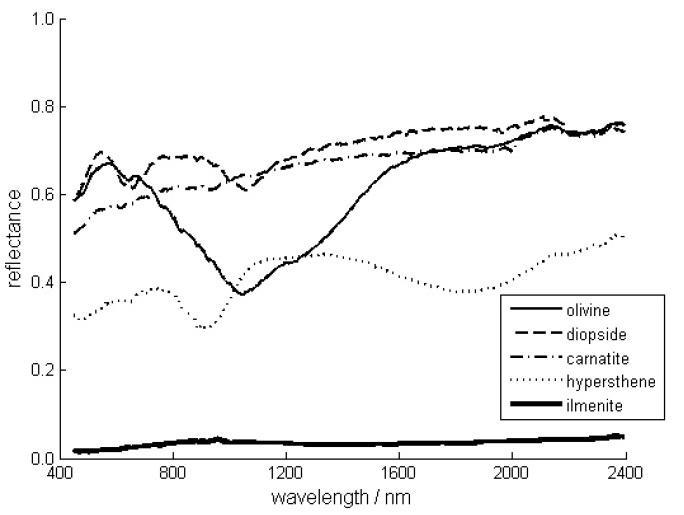

Here is an interesting scientific discovery made by the Yuuta-2 rover using a VNIS spectrometer - the soil in the landing zone of the Chang'e-4 mission apparatus contains olivine and pyroxene - high-density minerals with a low calcium content and high iron content, which hit the surface from the upper the mantle of the moon under the South Pole – Aitken basin after the shock event that created the nearby Finsen crater.
Lunar basalts and plagioclases that became material for the formation of a regolith layer covering the surface of the moon were discovered earlier, and they were brought to Earth in large quantities from the moon for research.
And in this discovery, elements that are contained in the lunar mantle (very deep), and not on the surface, were found on the surface of the moon. But they found it scientifically - they did not drill hundreds of kilometers inland, but explored the area on the far side of the moon, to which, as a result of a meteorite / asteroid impact into a nearby crater, particles of the upper mantle were ejected from the depths of the moon.
The first discovery, which was made back in January 2019: an analysis of data from the temperature sensors of the Chang'e-4 apparatus showed that on the surface during the lunar night on the far side of the moon, the temperature drops to -190 ° C.
By the way, a special Chinese Internet portal “System of publications and collection of scientific data and studies of the lunar and deep space” continues to work, where the received data and images from Chang'e-4 have already begun to be published and processed (and there already are gigabytes of data from earlier missions).
→ Path to the portal
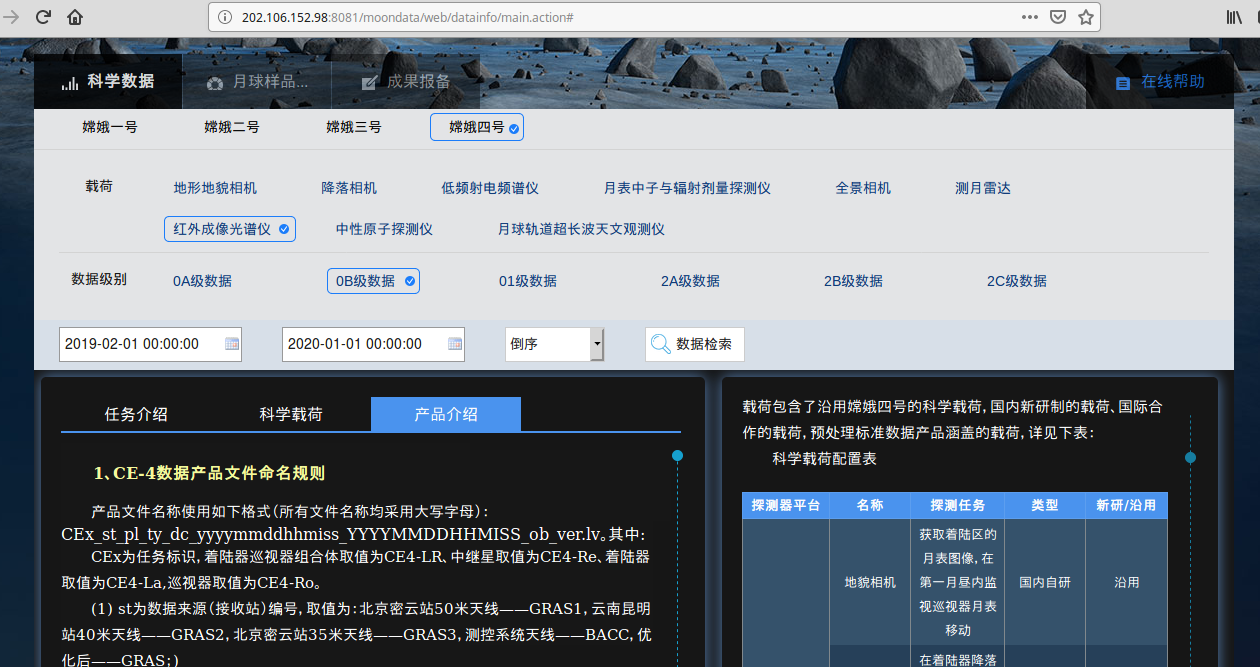
So lunar research continues, and new discoveries await us:


Source: https://habr.com/ru/post/452316/
All Articles